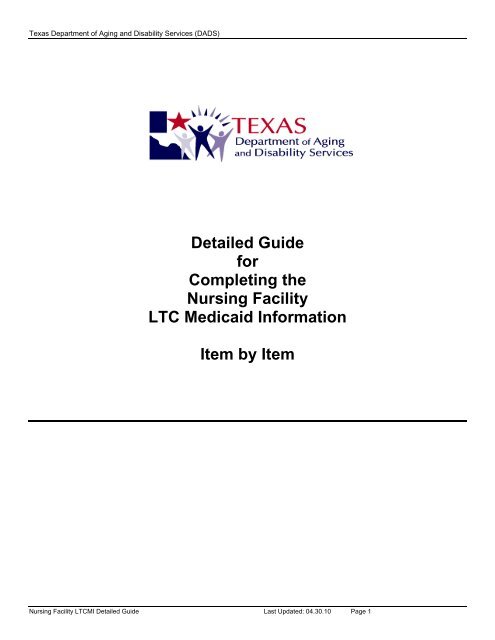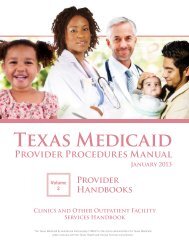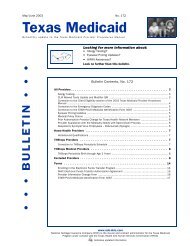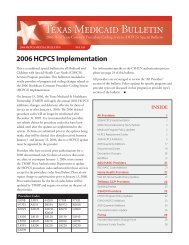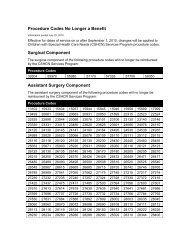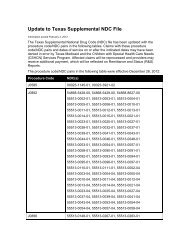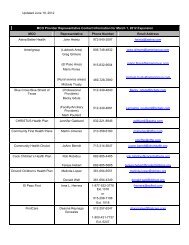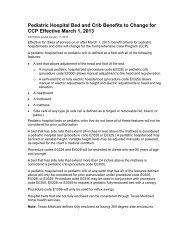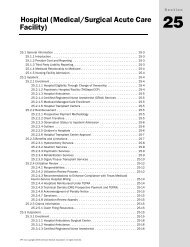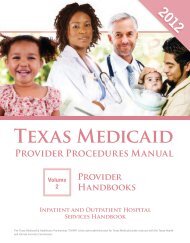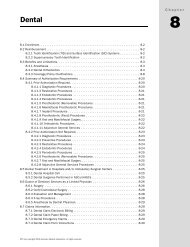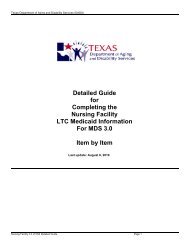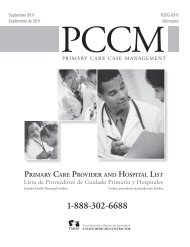LTCMI 2.0 – Nursing Facility Instructions - TMHP.com
LTCMI 2.0 – Nursing Facility Instructions - TMHP.com
LTCMI 2.0 – Nursing Facility Instructions - TMHP.com
You also want an ePaper? Increase the reach of your titles
YUMPU automatically turns print PDFs into web optimized ePapers that Google loves.
Texas Department of Aging and Disability Services (DADS)<br />
Detailed Guide<br />
for<br />
Completing the<br />
<strong>Nursing</strong> <strong>Facility</strong><br />
LTC Medicaid Information<br />
Item by Item<br />
<strong>Nursing</strong> <strong>Facility</strong> <strong>LTCMI</strong> Detailed Guide Last Updated: 04.30.10 Page 1
Texas Department of Aging and Disability Services (DADS)<br />
Table of Contents<br />
OVERVIEW.............................................................................................................................................................................................3<br />
CODING CONVENTIONS...........................................................................................................................................................................3<br />
SECTION LTC MEDICAID INFORMATION ...................................................................................................................................4<br />
S1. CLAIMS PROCESSING INFORMATION.................................................................................................................................................4<br />
S2. PASARR INFORMATION...................................................................................................................................................................5<br />
S3. PHYSICIAN’S EVALUATION & RECOMMENDATION ...........................................................................................................................5<br />
S4. LICENSES..........................................................................................................................................................................................6<br />
S5. PRIMARY DIAGNOSIS & ASSOCIATED MEDICATIONS........................................................................................................................7<br />
S6. THERAPEUTIC INTERVENTIONS.........................................................................................................................................................7<br />
S7. FOR DADS USE ONLY .....................................................................................................................................................................7<br />
S8. RECIPIENT ADDRESS.........................................................................................................................................................................7<br />
S9. MEDICATIONS...................................................................................................................................................................................8<br />
S10. COMMENTS...................................................................................................................................................................................13<br />
REVISIONS LOG .................................................................................................................................................................................14<br />
<strong>Nursing</strong> <strong>Facility</strong> <strong>LTCMI</strong> Detailed Guide Last Updated: 04.30.10 Page 2
Texas Department of Aging and Disability Services (DADS)<br />
Overview<br />
This guide is to be used in conjunction with <strong>TMHP</strong>’s LTC Online Portal. The entry of <strong>LTCMI</strong> (Long-Term Care<br />
Medicaid Information) can ONLY occur after the submission of the Federal MDS Assessments and retrieval<br />
on <strong>TMHP</strong>’s LTC Online Portal. This document covers only the <strong>LTCMI</strong> portion of the Assessments. All other<br />
Assessment field information can be found on the Federal CMS website. www.cms.hhs.gov.<br />
Coding Conventions<br />
The following coding conventions should be used when preparing the <strong>LTCMI</strong> as follows:<br />
• When <strong>com</strong>pleting hard copy forms to be used for data entry, capital letters may be easiest to read. Print<br />
legibly.<br />
• Dates - Where recording month, day, and year, enter two digits for the month and the day, and four<br />
digits for the year (mm.dd.yyyy). For example, the sixth of July in the year 2006 is recorded:<br />
07/06/2006.<br />
• Fields are conditionally required. Not all fields are always required. Answers to various fields determine<br />
what downstream fields are required. Example: Date of Previous PASARR is only required if an answer<br />
of Yes is entered for “Has the recipient had a previous PASARR assessment?”<br />
• Always choose the most appropriate response from the values provided in the Portal. Values are<br />
provided here for reference however might not be inclusive of all values.<br />
<strong>Nursing</strong> <strong>Facility</strong> <strong>LTCMI</strong> Detailed Guide Last Updated: 04.30.10 Page 3
Texas Department of Aging and Disability Services (DADS)<br />
Section LTC MEDICAID INFORMATION<br />
S1. Claims Processing Information<br />
S1a. DADS Vendor/Site ID Number<br />
Required field.<br />
Enter DADS Vendor or Site ID Number assigned by HHSC-DADS to the nursing facility in which<br />
the recipient is staying.<br />
This field should be auto populated based on the NPI number in field W1. This field is not<br />
correctable.<br />
S1b. Contract/Provider Number<br />
Required field.<br />
Enter your provider’s nine-digit Contract or Provider Number<br />
This field should be auto populated based on the NPI number in field W1. This field is not<br />
correctable.<br />
S1c. Service Group<br />
Required field.<br />
Enter the number that corresponds to the appropriate response:<br />
1. <strong>Nursing</strong> <strong>Facility</strong><br />
10. Swing Beds<br />
This field is not correctable once successfully submitted.<br />
S1d. Hospice Contract Number<br />
Required field if P1ao. Hospice Care is checked.<br />
Enter the Medicaid hospice provider contract number assigned by DADS.<br />
S1e. Purpose Code<br />
Enter the value that corresponds to the appropriate response:<br />
E. Recovery of Lost Payment<br />
M. Retro MN<br />
S1f. Missed Assessment Start Date<br />
Required field if S1e. Purpose Code = E or M.<br />
Enter the date in mm/dd/yyyy format of the missed assessment start date.<br />
Date must be September 1, 2008 thru and including October 31, 2010.<br />
S1g. Missed Assessment End Date<br />
Required field if S1e. Purpose Code = E or M.<br />
Enter the date in mm/dd/yyyy format of the missed assessment end date.<br />
Date must be on or after the Start Date and no later than October 31, 2010.<br />
<strong>Nursing</strong> <strong>Facility</strong> <strong>LTCMI</strong> Detailed Guide Last Updated: 04.30.10 Page 4
Texas Department of Aging and Disability Services (DADS)<br />
S2. PASARR Information<br />
S2a. To your knowledge, does the recipient have a condition of mental illness?<br />
Required field.<br />
Enter the most appropriate response: Y = YES or N = NO.<br />
S2b. To your knowledge, does the recipient have a related condition?<br />
Required field.<br />
Enter the most appropriate response: Y = YES or N = NO.<br />
S2c. To your knowledge, does the recipient have mental retardation?<br />
Required field.<br />
Enter the most appropriate response: Y = YES or N = NO.<br />
ENTRY TIP: If one value from S2a - S2c is a ‘Y’, then a PASARR Screening must be on file.<br />
S2d. Is the recipient a danger to himself / herself?<br />
Required field.<br />
Enter the most appropriate response: Y = YES or N = NO.<br />
If unknown, then reply with N = NO.<br />
S2e. Is the recipient a danger to others?<br />
Required field.<br />
Enter the most appropriate response: Y = YES or N = NO.<br />
If unknown, then reply with N = NO.<br />
S2f. Has the recipient had a previous PASARR assessment?<br />
Optional field.<br />
Enter the most appropriate response:<br />
Y = YES<br />
N = NO<br />
U = Unknown<br />
S2g. Date of previous PASARR assessment.<br />
Optional field.<br />
Enter the R2B date in mm/dd/yyyy format of the previous PASARR assessment, if known.<br />
S2i. Are specialized services indicated?<br />
This is a DADS ONLY field.<br />
S3. Physician’s Evaluation & Re<strong>com</strong>mendation<br />
<strong>Nursing</strong> <strong>Facility</strong> <strong>LTCMI</strong> Detailed Guide Last Updated: 04.30.10 Page 5
Texas Department of Aging and Disability Services (DADS)<br />
S3a. Do you have plans for the eventual discharge of this patient?<br />
Required if Initial Assessment, SCSA or Recovery of Lost Payment (Purpose Code E).<br />
Enter the most appropriate response: Y = YES or N = NO.<br />
S3b. Rehabilitative Potential<br />
Enter the most appropriate response:<br />
1 = Good<br />
2 = Fair<br />
3 = Minimal<br />
S3c. I certify that this individual requires nursing facility services or alternative based <strong>com</strong>munity<br />
services under supervision of an MD/DO.<br />
Required if Initial Assessment, SCSA or Recovery of Lost Payment (Purpose Code E).<br />
Enter the most appropriate response: Y = YES or N = NO.<br />
S3d. MD/DO Last Name<br />
Required field.<br />
Enter the last name of the MD/DO<br />
S3e. MD/DO License #<br />
Required field if S3f. MD/DO Military Spec Code # is not populated.<br />
Enter the license number of the MD/DO<br />
This number is validated against the Texas Medical Board file<br />
Physicians are not required to <strong>com</strong>plete the RUG training<br />
S3f. MD/DO Military Spec Code #<br />
S4. Licenses<br />
Required field if S3e. MD/DO License # is not populated.<br />
Enter the Military Spec Code number of the MD/DO<br />
S4a. RN Coordinator Last Name<br />
Required field.<br />
Enter the last name of the RN Coordinator<br />
S4b. RN Coordinator License #<br />
Required field.<br />
Enter the license number of the RN Coordinator<br />
This number is validated against the TBN (Texas Board of <strong>Nursing</strong>) or Compact License as<br />
applicable<br />
This number is validated to ensure RUG training requirements have been met<br />
<strong>Nursing</strong> <strong>Facility</strong> <strong>LTCMI</strong> Detailed Guide Last Updated: 04.30.10 Page 6
Texas Department of Aging and Disability Services (DADS)<br />
S5. Primary Diagnosis & Associated Medications<br />
S5a. Primary Diagnosis ICD-9<br />
Enter a valid ICD-9 code for the recipient’s Primary Diagnosis.<br />
S6. Therapeutic Interventions<br />
S6a. Tracheostomy Care<br />
This is a required field.<br />
Enter the number corresponding to the appropriate response.<br />
1 = Less than once a week<br />
2 = 1 to 6 times a week<br />
3 = once a day<br />
4 = twice a day<br />
5 = 3 <strong>–</strong> 11 times a day<br />
6 = every 2 hours<br />
7 = hourly / continuous<br />
ENTRY TIP: A non-zero reply requires P1aj. Tracheostomy Care to be checked.<br />
S6b. Ventilator / Respirator<br />
This is a required field if P1al. Ventilator/Respirator is checked.<br />
BIPAP/CPAP should NOT be included inS6b.<br />
Enter the number corresponding to the appropriate response.<br />
0 = not receiving<br />
1 = Less than once a week<br />
2 = 1 to 6 times a week<br />
3 = once a day<br />
4 = twice a day<br />
5 = 3 <strong>–</strong> 11 times a day<br />
6 = 6 <strong>–</strong> 23 hours<br />
7 = 24-hour continuous<br />
S7. For DADS Use Only<br />
This section is reserved for DADS<br />
S8. Recipient Address<br />
S8a. Recipient Address<br />
S8b. City<br />
Enter the street address of the recipient.<br />
Enter the city of the recipient.<br />
<strong>Nursing</strong> <strong>Facility</strong> <strong>LTCMI</strong> Detailed Guide Last Updated: 04.30.10 Page 7
Texas Department of Aging and Disability Services (DADS)<br />
S8c. State<br />
Enter the state of the recipient.<br />
S8d. Zip Code<br />
S9. Medications<br />
Enter the zip code of the recipient.<br />
Elderly are highly susceptible to adverse drug reactions and drug interactions. Polypharmacy is the use of two<br />
or more medications for no apparent reasons or for the same purpose. Polypharmacy also occurs when a<br />
medication is used to treat an adverse reaction from another medication. Polypharmacy can occur when there<br />
is no regular and careful monitoring of individual’s prescribed medications.<br />
This section will assist in identifying potential problems related to polypharmacy, drug reactions and<br />
interactions. Further, this section can also help caregivers to identify potential physical and emotional problems<br />
an individual may be experiencing. For example, reviewing and documenting the frequency an individual uses<br />
a PRN pain medication, sleeping medication, or laxative may lead the interdisciplinary team to do further<br />
assessment related to underlying causes associated with the use of PRN medications.<br />
The coding instructions are extensive. Review them carefully. Study the examples and <strong>com</strong>plete the coding<br />
exercise at the end of this section.<br />
1. Medication Name and Dose Ordered. Identify and record all medications that the individual received in the<br />
last 30 days. Also identify and record any medications that may not have been given in the last 30 days, but<br />
are part of the individual regular medication regimen (e.g. monthly B-12 injections). Do not record PRN<br />
medications that were not administered in the last 30 days.<br />
Record the name of the medication and dose that was ordered by the physician in column 1. Write the<br />
name of the medication and dose ordered EXACTLY as it appears on the MAR. For example, if the<br />
MAR indicates Acetaminophen 650 mg, do not write Acetaminophen 325 mg. 2 tabs, even if two<br />
325mg. tablets are administered to the individual.<br />
Occasionally, dosages of medications may be changed during the 30-Day assessment period. The<br />
medication with dosage changes should be recorded separately.<br />
Code only medications that the physician orders. If a medication order is carried out off premises, (e.g.,<br />
a dose administered at a dialysis center), that should be included here. In this example, the nursing<br />
facility should be made aware (e.g., via report) of medication administered at the Dialysis Center, but<br />
there is no item on the assessment to capture this information. Dialysis itself is captured in P1ab.<br />
If during the observation period, both the generic and the brand name medications were administered<br />
(under the same order), it is up to the program to decide which to code. For example, the program may<br />
decide to routinely code the generic in such instances. Whatever the decision, it should be carried out<br />
consistently. Do not code both, a brand and generic name, as it would give the appearance of a double<br />
order of the same medication.<br />
<strong>Nursing</strong> <strong>Facility</strong> <strong>LTCMI</strong> Detailed Guide Last Updated: 04.30.10 Page 8
Texas Department of Aging and Disability Services (DADS)<br />
When an oral medication is crushed and administered via G-tube, use code 9, enteral tube. A note of<br />
caution: some oral medications should not be crushed.<br />
Stat orders are coded as 1 in the PRN column.<br />
All medications received by the individual, including over-the-counter medications, should be ordered<br />
by the physician and included.<br />
Record the total number of doses, not days, in the last 30 days, which the PRN medication was given.<br />
EXAMPLE FOR 1. MEDICATION NAME AND DOSE ORDERED<br />
Medications as listed on MAR for assessment period of 8/11/02-9/9/02<br />
A. Lasix 40 mg. daily p.o.<br />
B. Acetaminophen 325 mg. 2 tabs q3-4 hrs PRN p.o. (given 3 times in last 30 days)<br />
C. B-12 1cc q month IM (given 8/8/02)<br />
D. Isopto Carbachol 1.5% 2 drops OD TID<br />
E. Robitussin-DM 5cc HS PRN p.o. (not given in last 30 days)<br />
F. Motrin 300 mg. QID p.o. (discontinued 8/15/02)<br />
G. Dilantin 300 mg. HS p.o. (ordered 8/15/02)<br />
H. Theo-Dur 200 mg. BID p.o. (given 8/11-8/13/02 and then order discontinued)<br />
I. Theo-Dur 200 mg TID p.o. (given 8/14-8/16/02 and then order discontinued)<br />
J. Theo-Dur 400 mg BID p.o. (given 8/02)<br />
Complete Column 1. as follows:<br />
1. Medication Name and<br />
Dose Ordered<br />
Lasix 40 mg.<br />
Acetaminophen 325 mg. 2 tabs<br />
B-12 1cc<br />
Isopto Carbachol 1.5% 2 drops<br />
Motrin 300 mg.<br />
Dilantin 300 mg.<br />
Theo-Dur 200 mg.<br />
Theo-Dur 200 mg.<br />
Theo-Dur 400 mg.<br />
2. RA 3. Freq 4. PRN-n<br />
*Note that Robitussin-DM was not recorded because it was not given in the last 30 days.<br />
<strong>Nursing</strong> <strong>Facility</strong> <strong>LTCMI</strong> Detailed Guide Last Updated: 04.30.10 Page 9
Texas Department of Aging and Disability Services (DADS)<br />
2. Route of Administration. Determine the Route of Administration (RA) used to administer each medication.<br />
The MAR and the physician’s orders should identify the RA for each medication. Record the RA in column 2<br />
using the following codes:<br />
1=by mouth (PO) 5=subcutaneous (SQ) 8=inhalation<br />
2=sub lingual (SL) 6=rectal (R) 9=enteral tube<br />
3=intramuscular (IM) 7=topical 10=other<br />
4=intravenous (IV)<br />
EXAMPLE FOR 2. ROUTE OF ADMINISTRATION<br />
Medications as listed on MAR for assessment period of 8/11/02-9/9/02<br />
A. Mylanta 15 cc after meals p.o.<br />
B. Zantac 150 mg. q 12 hrs. Per tube<br />
C. Transderm nitro patch 2.5 1 patch daily<br />
D. NPH 15 U before breakfast daily SQ<br />
E. Lasix 80 mg. IV STAT<br />
F. Acetaminophen suppository 650 mg. q 4 hrs. PRN (given on 2 occasions in last 30 days)<br />
1. Medication Name and<br />
Dose Ordered<br />
2. RA 3. Freq 4. PRN-n<br />
Mylanta 15 cc 1<br />
Zantac 150 mg 9<br />
Transderm nitro patch 2.5 1 patch 7<br />
NPH 15 U 5<br />
Lasix 80 mg 4<br />
Acetaminophen suppository 650 mg. 6<br />
3. Frequency. Determine the number of times per day, week, or month that each medication is given. Record<br />
the frequency in column 3 using the following codes:<br />
PR=(PRN) as necessary 2D=(BID) two times daily QO=every other day<br />
1H=(QH) every hour (includes every 12 hrs) 4W=4 times each week 2H=(Q2H) every two hours<br />
3D=(TID) three times daily 5W=five times each week 3H=(Q3H) every three hours<br />
4D=(QID) four times daily 6W=six times each week 4H=(Q4H) every four hours<br />
5D=five times daily 1M=(Q mo) once every month<br />
6H=(Q6H) every six hours 1W=(Q week) once each wk 2M=twice every month 8H=(Q8H) every eight hours<br />
2W=two times every week C=continuous<br />
1D=(QD or HS) once daily 3W=three times every week O=other<br />
Be careful to differentiate between similar frequencies. For example, some programs have a policy that<br />
antibiotics are to be administered around the clock. Therefore, if an antibiotic is ordered as T.I.D., the<br />
medication may actually be given q 8 hours. There is a different frequency code for T.I.D. (3D) and q 8 hrs<br />
(8H). In this case, the frequency code would be 8H (q 8 hrs.). If insulin is given on a sliding scale, each<br />
different dose of insulin given is entered as a PRN medication.<br />
<strong>Nursing</strong> <strong>Facility</strong> <strong>LTCMI</strong> Detailed Guide Last Updated: 04.30.10 Page 10
Texas Department of Aging and Disability Services (DADS)<br />
EXAMPLE FOR 3. FREQUENCY<br />
Medications as listed on MAR for assessment period of 8/11/02-9/9/02<br />
A. Ampicillin 250 mg. q 6 hrs x 10 days p.o. (8/10-8/20)<br />
B. Beconase nasal inhaler 1 puff BID<br />
C. Compazine suppository 5 mg. STAT<br />
D. Lanoxin 0.25 mg. p.o. every other day. On alternate days, give Lanoxin 0.125 mg. p.o.<br />
E. Peri-colace 2 capsules HS p.o.<br />
F. NPH 15 U before breakfast daily SQ<br />
G. Check blood sugar daily at 4 p.m. Sliding scale insulin: NPH 5 units if blood sugar 200-<br />
300; 10 units if over 300. (5 units given on 8/11/02 for BS of 255; 5 units given on 8/13/02 for<br />
BS of 233; 10 units given on 8/17/02 for BS of 305)<br />
1. Medication Name and<br />
Dose Ordered<br />
2. RA 3. Freq 4. PRN-n<br />
Ampicillin 250 mg 1 6h<br />
Beconase nasal inhaler 1 puff 8 2d<br />
Compazine suppository 5 mg. 6 PR<br />
Lanoxin 0.25 mg 1 QO<br />
Lanoxin 0.125 mg 1 QO<br />
Peri-colace 2 capsules 1 1D<br />
NPH 15 U. 5 1D<br />
NPH 5 U. 5 PR<br />
NPH 10 U. 5 PR<br />
4. PRN-Number of Doses (PRN-n). The PRN-n column is only <strong>com</strong>pleted for medications that have a<br />
frequency as PR. Record the number of times in the past 30 days that each medication coded as PR was<br />
given. STAT medications are recorded as a PRN medication. Remember, if a PRN medication was not given<br />
in the past 30 days, it should not be listed here.<br />
<strong>Nursing</strong> <strong>Facility</strong> <strong>LTCMI</strong> Detailed Guide Last Updated: 04.30.10 Page 11
Texas Department of Aging and Disability Services (DADS)<br />
Coding Exercises for S9. Medications<br />
Complete the practice form on the next page for the following medications during a 30-day period (8/11/02-<br />
9/9/02):<br />
1. Inderal 40 mg. BID p.o.<br />
2. Sinemet 10/100 TID p.o.<br />
3. Artificial Tears 1 drop OU QID<br />
4. Anusol HC suppository 1 PRN (given 1 time in last 30 days)<br />
5. Amoxicillin 500 mg q 6 hrs per tube<br />
6. Benylin cough syrup 2 tbs. PRN p.o. (given 10 times in last 30 days)<br />
7. Darvocet-N 100 2 tabs q 4-6 hrs PRN p.o. (given 5 times in last 30 days)<br />
8. Heparin lock flush 10 U daily<br />
9. Ditropan syrup 2.5 mg daily p.o.<br />
10. Nitrotransdermal .4 mg 1 patch daily<br />
11. Novolin N 24 U before breakfast SQ<br />
12. Check blood sugar before breakfast. Sliding scale insulin: Novolin R 10 units if blood sugar over 200. (10<br />
units given on 2 days in last 30 days)<br />
13. Questran 1 packet with each meal p.o.<br />
14. Quinine sulfate 325 mg. HS<br />
15. Coumadin 2.5 mg daily p.o. (discontinued 9/3/02)<br />
16. Coumadin 5 mg. daily p.o. (ordered to start on 9/4/02)<br />
17. Maalox 15 cc PRN for indigestion p.o. (not administered in last 30 days)<br />
Complete the practice form and <strong>com</strong>pare your form with the answers on the next page<br />
1. Medication Name and Dose Ordered 2. RA 3. Freq 4. PRN-n<br />
<strong>Nursing</strong> <strong>Facility</strong> <strong>LTCMI</strong> Detailed Guide Last Updated: 04.30.10 Page 12
Texas Department of Aging and Disability Services (DADS)<br />
S9. Medications exercise answer form.<br />
1. Medication Name and<br />
Dose Ordered<br />
2. RA 3. Freq 4. PRN-n<br />
Inderal 40 mg. 1 2D<br />
Sinemet 10/100 1 3D<br />
Artificial Tears 1 drop 7 4D<br />
Anusol HC suppository 1 6 PR 1<br />
Amoxicillin 500 mg. 9 6H<br />
Benylin cough syrup 2 Tbs. 1 PR 10<br />
Darvocet-N 100 2 tabs 1 PR 5<br />
Heparin lock flush 10 U 4 1D<br />
Ditropan syrup 2.5 mg 1 1D<br />
Nitrotransdermal .4 mg 7 1D<br />
Novolin N 24 U 5 1D<br />
Novolin R 10 U 5 PR 2<br />
Questran 1 packet 1 3D<br />
Quinine sulfate 325 mg. 1 1D<br />
Coumadin 2.5 mg 1 1D<br />
Coumadin 5 mg 1 1D<br />
S10. Comments<br />
Enter up to 500 characters if needed<br />
<strong>Nursing</strong> <strong>Facility</strong> <strong>LTCMI</strong> Detailed Guide Last Updated: 04.30.10 Page 13
Texas Department of Aging and Disability Services (DADS)<br />
Revisions Log<br />
Update Date Update Description<br />
April 30, 2010 Changed S1f and S1g to include date limitations.<br />
<strong>Nursing</strong> <strong>Facility</strong> <strong>LTCMI</strong> Detailed Guide Last Updated: 04.30.10 Page 14


